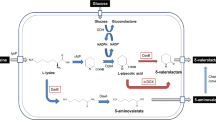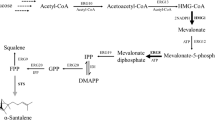Abstract
Fatty dicarboxylic acids (FDCA) are useful as starting materials or components for plastics, polyesters, nylons, and fragrances. Most of the commercially available FDCA contain an even number of carbons, and there remain few sustainable methods for production of FDCA with an odd number of carbons (o-FDCA). In this work, we explored a novel biosynthetic route to unsaturated o-FDCA. The approach was based on genetic modifications of hsaf pks-nrps, encoding a hybrid polyketide synthase–nonribosomal peptide synthetase (PKS–NRPS) in Lysobacter enzymogenes, an environmental bacterium emerging as a new biocontrol agent. This single-module PKS–NRPS catalyzes the biosynthesis of lysobacterene A, a polyene-containing precursor of the antifungal natural product Heat-Stable Antifungal Factor (HSAF). We genetically removed the NRPS module from this gene and generated a new strain of L. enzymogenes, in which the PKS module was fused to the thioesterase domain of hsaf pks–nrps. The chimeric gene was verified by DNA sequencing, and its expression in L. enzymogenes was confirmed by reverse transcription-polymerase chain reaction (RT-PCR). The total fatty acids were extracted, esterified, and analyzed by GC–MS. The results showed that the engineered strain produced new fatty acids that were absent in the wild type. The main product was identified as hepta-2,4-dienedioic acid, an unsaturated o-FDCA. This work sets the foundation to explore a sustainable and environment-friendly approach toward unsaturated o-FDCA, which could be used as precursors for new compounds that can serve as versatile feedstock for industrial materials.
Graphical Abstract




Similar content being viewed by others
References
Stempfle, F., Ortmann, P., & Mecking, S. (2016). Long-chain aliphatic polymers to bridge the gap between semicrystalline polyolefins and traditional polycondensates. Chemical Reviews, 116, 4597–4641.
Kroha, K. J. (2004). Industrial biotechnology provides opportunities for commercial production of new long-chain dibasic acids. Inform, 15, 568–571.
Barbiroli, G., Lorenzetti, C., Berti, C., Fiorini, M., & Manaresi, P. (2003). Polyethylene like polymers. Aliphatic polyesters of dodecanedioic acid: 1 Synthesis and properties. European Polymer Journal, 39, 655–661.
Huf, S., Krügener, S., Hirth, T., Rupp, S., & Zibek, S. (2011). Biotechnological synthesis of long-chain dicarboxylic acids as building blocks for polymers. European Journal of Lipid Science and Technology, 113, 548–561.
Ferreira, B., Pais, C., Franco-Duarte, R., Sampaio, P., Wildner, J., Carolas, A. and Figueira, D. (2016). Production of dicarboxylic acid platform chemicals using yeasts: focus on succinic acid, in Biotransformation of Agricultural Waste and By-Products, pp. 237–269.
Niu, W., Draths, K. M., & Frost, J. W. (2002). Benzene-free synthesis of adipic acid. Biotechnology Progress, 18, 201–211.
Yu, J. L., Xia, X. X., Zhong, J. J., & Qian, Z. G. (2014). Direct biosynthesis of adipic acid from a synthetic pathway in recombinant Escherichia coli. Biotechnology and Bioengineering, 111, 2580–2586.
Beardslee, T., & Picataggio, S. (2012). Bio-based adipic acid from renewable oils. Lipid Technology, 24, 223–225.
Hagen, A., Poust, S., Rond, T. D., Fortman, J. L., Katz, L., Petzold, C. J., & Keasling, J. D. (2016). Engineering a polyketide synthase for in vitro production of adipic acid. ACS Synthetic Biology, 5, 21–27.
Zhao, M., Huang, D., Zhang, X., Koffas, M. A. G., Zhou, J., & Deng, Y. (2018). Metabolic engineering of Escherichia coli for producing adipic acid through the reverse adipate-degradation pathway. Metabolic Engineering, 47, 254–262.
Clomburg, J. M., Blankschien, M. D., Vick, J. E., Chou, A., Kim, S., & Gonzalez, R. (2015). Integrated engineering of β-oxidation reversal and ω-oxidation pathways for the synthesis of medium chain ω-functionalized carboxylic acids. Metabolic Engineering, 28, 202–212.
Turk, S. C. H. J., Kloosterman, W. P., Ninaber, D. K., Kolen, K. P. A. M., Knutova, J., Suir, E., Schürmann, M., Raemakers-Franken, P. C., Müller, M., de Wildeman, S. M. A., Raamsdonk, L. M., van der Pol, R., Wu, L., Temudo, M. F., van der Hoeven, R. A. M., Akeroyd, M., van der Stoel, R. E., Noorman, H. J., Bovenberg, R. A. L., & Trefzer, A. C. (2016). Metabolic engineering toward sustainable production of nylon-6. ACS Synthetic Biology, 5, 65–73.
Raj, K., Partow, S., Correia, K., Khusnutdinova, A. N., Yakunin, A. F., & Mahadevan, R. (2018). Biocatalytic production of adipic acid from glucose using engineered Saccharomyces cerevisiae. Metabolic Engineering Communications, 6, 28–32.
Lee, S. J., Song, H., & Lee, S. Y. (2006). Genome-based metabolic engineering of Mannheimia succiniciproducens for succinic acid production. Applied and Environmental Microbiology, 72, 1939–1948.
Takeuchi, M., Kishino, S., Park, S. B., Kitamura, N., Watanabe, H., Saika, A., Hibi, M., Yokozeki, K., & Ogawa, J. (2016). Production of dicarboxylic acids from novel unsaturated fatty acids by laccase-catalyzed oxidative cleavage. Bioscience, Biotechnology, and Biochemistry, 80, 2132–2137.
Liu, R. H., Smith, M. K., Basta, S. A., & Farmer, E. R. (2006). Azelaic acid in the treatment of papulopustular rosacea: A systematic review of randomized controlled trials. Archives of Dermatology, 142, 1047–1052.
Pathak, M. A., Ciganek, E. R., Wick, M., Sober, A. J., Farinelli, W. A., & Fitzpatrick, T. B. (1985). An evaluation of the effectiveness of azelaic acid as a depigmenting and chemotherapeutic agent. The Journal of Investigative Dermatology, 85, 222–228.
Haushalter, R. W., Phelan, R. M., Hoh, K. M., Su, C., Wang, G., Baidoo, E. E. K., & Keasling, J. D. (2017). Production of odd-carbon dicarboxylic acids in Escherichia coli using an engineered biotin–fatty acid biosynthetic pathway. Journal of the American Chemical Society, 139, 4615–4618.
Lee, Y., Sathesh-Prabu, C., Kwak, G. H., Bang, I., Jung, H. W., Kim, D., & Lee, S. K. (2021). Enhanced production of nonanedioic acid from nonanoic acid by engineered Escherichia coli. Biotechnology Journal. https://doi.org/10.1002/biot.202000416
Khalil, I., Quintens, G., Junkers, T., & Dusselier, M. (2020). Muconic acid isomers as platform chemicals and monomers in the biobased economy. Green Chemistry, 22, 1517–1541.
Xie, Y., Wright, S., Shen, Y., & Du, L. (2012). Bioactive natural products from Lysobacter. Natural Product Reports, 29, 1277–1287.
Yue, H., Miller, A. L., Khetrapal, V., Jayaseker, V., Wright, S., & Du, L. (2022). Biosynthesis, regulation, and engineering of natural products from Lysobacter. Natural Product Reports, 39, 842–874.
Yu, F., Zaleta-Rivera, K., Zhu, X., Huffman, J., Millet, J. C., Harris, S. D., Yuen, G., Li, X.-C., & Du, L. (2007). Structure and biosynthesis of heat-stable antifungal factor (HSAF), a broad-spectrum antimycotic with a novel mode of action. Antimicrobial Agents and Chemotherapy, 51, 64–72.
Li, Y., Chen, H., Ding, Y., Xie, Y., Wang, H., Cerny, R. L., Shen, Y., & Du, L. (2014). Iterative assembly of two separate polyketide chains by the same single-module bacterial polyketide synthase in the biosynthesis of hsaf. Angewandte Chemie International Edition, 53, 7524–7530.
Lou, L., Qian, G., Xie, Y., Hang, J., Chen, H., Zaleta-Rivera, K., Li, Y., Shen, Y., Dussault, P. H., Liu, F.-Q., & Du, L. (2011). Biosynthesis of HSAF, a tetramic acid-containing macrolactam from Lysobacter enzymogenes. Journal of the American Chemical Society, 133(4), 643–645.
Li, Y., Wang, H., Liu, Y., Jiao, Y., Li, S., Shen, Y., & Du, L. (2018). Biosynthesis of the polycyclic system in the antifungal hsaf and analogues from Lysobacter enzymogenes. Angewandte Chemie International Edition, 57, 6221–6225.
Quandt, J., & Hynes, M. F. (1993). Versatile suicide vectors which allow direct selection for gene replacement in Gram-negative bacteria. Gene, 127, 15–21.
Hoang, T. T., Karkhoff-Schweizer, R. R., Kutchma, A. J., & Schweizer, H. P. (1998). A broad-host-range Flp-FRT recombination system for site-specific excision of chromosomally-located DNA sequences: Application for isolation of unmarked Pseudomonas aeruginosa mutants. Gene, 212, 77–86.
Heckman, K. L., & Pease, L. R. (2007). Gene splicing and mutagenesis by PCR-driven overlap extension. Nature Protocols, 2, 924–932.
Liu, G., Tian, Y., Yang, H., & Tan, H. (2005). A pathway-specific transcriptional regulatory gene for nikkomycin biosynthesis in Streptomyces ansochromogenes that also influences colony development. Molecular Microbiology, 55, 1855–1866.
Politz, M., Lennen, R., & Pfleger, B. (2013). Quantification of bacterial fatty acids by extraction and methylation. Bio Protocol, 3, e950.
McLafferty, F. W., & Turecek, F. (1994). Interpretation of mass spectra (4th ed.). University Science Books.
Hallgren, B., Ryhage, R., & Stenhagen, E. (1959). The mass spectra of methyl oleate, methyl linoleate, and methyl linolenate. Acta Chemica Scandinavica, 13, 845–847.
Christie, W. W., & Han, X. (2012). Gas chromatographic analysis of fatty acid derivatives. In W. W. Christie & X. Han (Eds.), Lipid analysis (pp. 159–180). Woodhead Publishing.
Becker, J., Zelder, O., Hafner, S., Schroder, H., & Wittmann, C. (2011). From zero to hero-design-based systems metabolic engineering of Corynebacterium glutamicum for L-lysine production. Metabolic Engineering, 13, 159–168.
Lee, S. J., Lee, D. Y., Kim, T. Y., Kim, B. H., Lee, J., & Lee, S. Y. (2005). Metabolic engineering of Escherichia coli for enhanced production of succinic acid, based on genome comparison and in silico gene knockout simulation. Applied and Environmental Microbiology, 71, 7880–7887.
Bro, C., Regenberg, B., Forster, J., & Nielsen, J. (2006). In silico aided metabolic engineering of Saccharomyces cerevisiae for improved bioethanol production. Metabolic Engineering, 8, 102–111.
Lamsa, M., & Bloebaum, P. (1990). Mutation and screening to increase chymosin yield in a genetically-engineered strain of Aspergillus awamori. Journal of Industrial Microbiology, 5, 229–237.
Acknowledgements
The study was financially supported in part by University of Nebraska Collaboration Initiative Seed Grant, and the Nebraska Public Power District through the Nebraska Center for Energy Sciences Research at the University of Nebraska-Lincoln. The authors would like to thank Drs. Martha Morton, Thomas Smith, and Virendra Tiwari for technical supports in identification of the fatty acids, and Drs. Lingjun Yu and Yuan Chen for assistance in molecular cloning experiments.
Author information
Authors and Affiliations
Contributions
LD and PHD designed the research. VK performed the experiments. VK, LD, and PHD analyzed data. VK and LD wrote the manuscript. PD edited the manuscript. All authors read and approved the manuscript.
Corresponding author
Ethics declarations
Conflict of interest
The authors declare that they have no conflict of interest.
Additional information
Publisher's Note
Springer Nature remains neutral with regard to jurisdictional claims in published maps and institutional affiliations.
Supplementary Information
Below is the link to the electronic supplementary material.
Rights and permissions
About this article
Cite this article
Khetrapal, V., Dussault, P. & Du, L. Biosynthesis of Odd-Carbon Unsaturated Fatty Dicarboxylic Acids Through Engineering the HSAF Biosynthetic Gene in Lysobacter enzymogenes. Mol Biotechnol 64, 1401–1408 (2022). https://doi.org/10.1007/s12033-022-00520-1
Received:
Accepted:
Published:
Issue Date:
DOI: https://doi.org/10.1007/s12033-022-00520-1




